Early Triassic (Griesbachian) Deposits of High-Energy Events at the Northwestern Upper Yangtze Region, China
Abstract
:1. Introduction
2. Geologic and Stratigraphic Setting


3. Materials and Methods
4. Results
4.1. Shangsi Section
4.2. Dagouli Section
4.3. Jianfeng Section
4.4. Yudongzi Section
5. Discussion
5.1. A Comparison of the Studied Outcrops
5.2. Assessing the Diagenetic Effects for Member 1 of the Feixianguan Formation
5.3. Potential High-Energy Events
5.3.1. Seismic Event and Tsunami
5.3.2. Storms
5.4. Origin of High-Energy Event Deposits
5.5. Depositional Model
6. Conclusions
Author Contributions
Funding
Data Availability Statement
Acknowledgments
Conflicts of Interest
References
- Erwln, D.H. The Permo-Triassic extinction. Nature 1994, 367, 231–236. [Google Scholar]
- Tong, J.N.; Lin, Q.X.; Shi, G.R. Evolution of the Permian and Triassic reef ecosystems in South China. Proc. Royal. Soc. Victoria 1998, 110, 385–399. [Google Scholar]
- Racki, G. Silica-secreting biota and mass extinctions: Survival patterns and processes. Palaeogeogra. Palaeoclimatol. Palaeoecol. 1999, 154, 107–132. [Google Scholar] [CrossRef]
- Retallack, G.J.; Veevers, J.J.; Morante, R. Global coal gap between Permian-Triassic extinction and Middle Triassic recovery of peat-forming plants. GSA Bull. 1996, 108, 195–207. [Google Scholar] [CrossRef]
- Fraiser, M.L.; Bottjer, D.J. Restructuring of benthic level-bottom shallow marine communities due to prolonged environmental stress during the aftermath of the end-Permian mass extinction. C. R. Palevol. 2005, 4, 15–23. [Google Scholar] [CrossRef]
- Abdolmaleki, J.; Tavakoli, V. Anachronistic facies in the early Triassic successions of the Persian Gulf and its palaeoenvironmental reconstruction. Palaeogeogra. Palaeoclimatol. Palaeoecol. 2016, 446, 213–224. [Google Scholar] [CrossRef]
- Wignall, P.B.; Twitchett, R.J. Unusual intraclastic limestones in Lower Triassic carbonatesand their bearing on the aftermath of the end-Permian mass extinction. Sedimentology 1999, 46, 303–316. [Google Scholar] [CrossRef]
- Woods, A.D. Assessing Early Triassic paleoceanographic conditions via unusual sedimentary fabrics and features. Earth Sci. Rev. 2014, 137, 6–18. [Google Scholar] [CrossRef]
- Zhao, X.M.; Tong, J.N.; Yao, H.Z.; Zhang, K.X.; Chen, Z.Q. Anachronistic facies in the Lower Triassic of South China and their implications to the ecosystems during the recovery time. Sci. Chin. Ser. D Ear. Sci. 2008, 51, 1646–1657. [Google Scholar] [CrossRef]
- Woods, A.D. Microbial ooids and cortoids from the Lower Triassic (Spathian) Virgin Limestone, Nevada, USA: Evidence for an Early Triassic microbial bloom in shallow depositional environments. Glob. Planet Chang. 2013, 105, 91–101. [Google Scholar] [CrossRef]
- Deng, B.Z.; Wang, Y.B.; Woods, A.D.; Li, S.; Li, G.S.; Chen, W.H. Evidence for rapid precipitation of calcium carbonate in South China at the beginning of Early Triassic. Palaeogeogra. Palaeoclimatol. Palaeoecol. 2017, 474, 187–197. [Google Scholar] [CrossRef]
- Pruss, S.B.; Corsetti, F.A.; Bottjer, D.J. The unusual sedimentary rock record of the Early Triassic: A case study from the southwestern United States. Palaeogeogra. Palaeoclimatol. Palaeoecol. 2005, 222, 33–52. [Google Scholar] [CrossRef]
- Woods, A.D.; Alms, P.D.; Monarrez, P.M.; Mata, S. The interaction of recovery and environmental conditions: An analysis of the outer shelf edge of western North America during the early Triassic. Palaeogeogra. Palaeoclimatol. Palaeoecol. 2019, 513, 52–64. [Google Scholar] [CrossRef]
- Chen, L.Z.; Luo, X.M.; Xiao, J.D. Early Triassic calcareous storm deposits in southeastern Hubei. Sediment. Fac. Palaeogeogra. 1991, 11, 1–9, (In Chinese with English abstract). [Google Scholar]
- Collinson, J.W.; Kendall, C.G.S.C.; Marcantel, J.B. Permian-Triassic boundary in eastern Nevada and west-central Utah. Geol. Soc. Am. Bull. 1976, 5, 821–824. [Google Scholar] [CrossRef]
- Alvarez, W.O.; Connor, D.; Koeberl, C. Permian-Triassic boundary in the southwestern United States: Hiatus or continuity? In Catastrophic Events and Mass Extinctions: Impacts and Beyond; Koeberl, C., MacLeod, K.G., Eds.; Geological Society of America: Boulder, CO, USA, 2002; Volume 356, pp. 385–393. [Google Scholar] [CrossRef]
- Moghadam, M.M.; Rafiei, B.; Richoz, S.; Woods, A.D.; Krystyn, L. Anachronistic facies and carbon isotopes during the end-Permian biocrisis: Evidence from the mid-Tethys (Kisejin, Iran). Palaeogeogra. Palaeoclimatol. Palaeoecol. 2019, 516, 364–383. [Google Scholar] [CrossRef]
- Chen, L.; Li, Y.; Cheng, Z. An overview of research and forecasting on rainfall associated with landfalling tropical cyclones. Adv. Atmos. Sci. 2010, 27, 967–976. [Google Scholar] [CrossRef]
- Sun, Y.D.; Wignall, P.B.; Joachimski, M.M.; Bond, D.P.G.; Grasby, S.E.; Sun, S.; Yan, C.B.; Wang, L.N.; Chen, Y.L.; Lai, X.L. High amplitude redox changes in the late Early Triassic of South China and the Smithian-Spathian extinction. Palaeogeogra. Palaeoclimatol. Palaeoecol. 2015, 427, 62–78. [Google Scholar] [CrossRef]
- Galfetti, T.; Bucher, H.; Martini, R.; Hochuli, P.A.; Weissert, H.; Crasquin-Soleau, S.; Guodun, K. Evolution of Early Triassic outer platform paleoenvironments in the Nanpanjiang Basin (South China) and their significance for the biotic recovery. Sediment. Geol. 2008, 204, 36–60. [Google Scholar] [CrossRef]
- Zhang, T.S.; Chen, X.H.; Liu, Z.C. Seismites and Their Geological Significance in Early Triassic of Southeast Sichuan Basin. Acta Sedimentol. Sin. 2012, 30, 477–485, (In Chinese with English abstract). [Google Scholar]
- Jamil, M.; Siddiqui, N.A.; Umar, M.; Ahmen, N.; Abdrahman, A.H.; Zaidi, F.K. Aseismic and seismic impact on development of soft-sediment deformation structures in deep-marine sand-shaly Crocker fan in Sabah, NW Borneo. J. King Saud Univ. Sci. 2021, 33, 101522. [Google Scholar] [CrossRef]
- Jamil, M.; Siddiqui, N.A.; Ahmen, N.; Usman, M.; Umar, M.; Rahim, H.; Imran, Q.S. Facies analysis and sedimentary architecture of hybrid event beds in submarine lobes: Insights from the Crocker Fan, NW Borneo, Malaysia. J. Mar. Sci. Eng. 2021, 9, 1133. [Google Scholar] [CrossRef]
- Zhao, Y.S.; Wang, D.Y.; Hu, Z.S. Sdimentology and Environment of Carbonate Gravity Flows on the Wester Margin of Lower Triassic Sichuan Basin. Acta Sedimentol. Sin. 1994, 12, 1–8, (In Chinese with English abstract). [Google Scholar]
- Jamil, M.; Siddiqui, N.A.; Usman, M.; Wahid, A.; Umar, M.; Ahmed, N.; Haq, I.U.; El-Ghali, M.A.K.; Imran, Q.S.; Rahman, A.H.A.; et al. Facies analysis and distribution of Late Palaeogene deep-water massive sandstones in submarine-fan lobes, NW Borneo. Geol. J. 2022, 57, 4489–4807. [Google Scholar] [CrossRef]
- Lehrmann, D.J.; Wan, Y.; Wei, J.Y.; Yu, Y.Y.; Xiao, J.F. Lower Triassic peritidal cyclic limestone:an example of anachronistic carbonate facies from the Great Bank of Guizhou, Nanpanjiang Basin, Guizhou province, South China. Palaeogeogra. Palaeoclimatol. Palaeoecol. 2001, 173, 103–123. [Google Scholar] [CrossRef]
- Shi, Z.Q.; Yi, H.S.; Zeng, D.Y.; Zhang, H. The lowest member of lower triassic feixianguan formation in upper yangtze region: Sedimentary records from sluggish water to turbulent ocean after the mass extinction. Geo. Rev. 2010, 56, 769–779, (In Chinese with English abstract). [Google Scholar]
- Enos, P.; Jiayong, W.; Yangji, Y. Facies distribution and retreat of Middle Triassic Platform margin, Guizhou province, South China. Sedimentology 1997, 44, 563–584. [Google Scholar] [CrossRef]
- Sun, S.; Li, J.; Chen, H.; Peng, H.; Hsu, K.J.; Shelton, J.W. Mesozoic and Cenozoic sedimentary history of South China. AAPG Bull. 1989, 10, 1247–1269. [Google Scholar]
- Wang, Y.G.; Wen, Y.C.; Hong, H.T.; Xiao, M.L.; Fan, Y.; Wen, L.; Kong, L.X.; Wu, C.H. Carbonate slope facies sedimentary characteristics of the Late Permian to Early Triassic in northern Sichuan Basin. J. Palaeogeogra. 2009, 11, 143–156, (In Chinese with English abstract). [Google Scholar]
- Huang, B.C.; Yan, Y.G.; Piper, J.D.A.; Zhang, D.H.; Yi, Z.Y.; You, S.; Zhou, T.H. Paleomagnetic constraints on the paleogeography of the East Asian blocks during late Paleozoic and early Mesozoic times. Earth Sci. Rev. 2018, 186, 8–36. [Google Scholar] [CrossRef]
- Wignall, P.B.; Hallam, A.; Lai, X.L.; Yang, F.Q. Palaeoenvironmental changes across the Permian/Triassic boundary at Shangsi (Sichuan basin). Histori. Biol. 1995, 10, 175–189. [Google Scholar] [CrossRef]
- Yuan, D.X.; Shen, S.Z.; Henderson, C.M.; Chen, J.; Zhang, H.; Zheng, Q.F.; Wu, H. Integrative timescale for the Lopingian (Late Permian): A review and update from Shangsi, South China. Earth Sci. Rev. 2019, 188, 190–209. [Google Scholar] [CrossRef]
- He, B.; Zhong, Y.T.; Xu, Y.G.; Li, X.H. Triggers of Permo-Triassic boundary mass extinction in South China: The Siberian Traps or Paleo-Tethys ignimbrite flare-up? Lithos 2014, 204, 258–267. [Google Scholar] [CrossRef]
- Kaihou, K.; Saito, R.; Ito, K.; Miyaji, T.; Biswas, R.; Tian, L.; Sano, H.; Shi, Z.Q.; Takahashi, S.; Tong, J.N.; et al. Effects of soil erosion and anoxic-euxinic ocean in the Permian-Triassic marine crisis. Heliyon 2016, 2, 00137. [Google Scholar] [CrossRef] [PubMed]
- Galfetti, T.; Bucher, H.; Ovtcharova, M.; Schaltegger, U.; Brayard, A.; Brühwiler, T.; Goudemand, N.; Weissert, H.; Hochuli, P.A.; Cordey, F.; et al. Timing of the Early Triassic carbon cycle perturbations inferred from new U-Pb ages and ammonoid biochronozones. Earth Planet. Sci. Lett. 2007, 258, 593–604. [Google Scholar] [CrossRef]
- Shen, S.Z.; Crowley, J.L.; Wang, Y.; Bowring, S.A.; Erwin, D.H.; Sadler, P.M.; Cao, C.Q.; Rothman, D.H.; Henderson, C.M.; Ramezani, J.; et al. Calibrating the end-Permian mass extinction. Science 2011, 334, 1367–1372. [Google Scholar] [CrossRef]
- Zheng, B.S.; Mou, C.L.; Wang, X.P.; Chen, H.D.; Xiao, Z.H. Paleoclimate and paleoceanographic evolution during the Permian-Triassic transition (western Hubei area, South China) and their geological implications. Palaeogeogra. Palaeoclimatol. Palaeoecol. 2021, 564, 110166. [Google Scholar] [CrossRef]
- Jiang, H.S.; Lai, X.L.; Yan, C.B.; Aldridge, R.J.; Wignall, P.B.; Sun, Y.D. Revised conodont zonation and conodont evolution across the Permian-Triassic boundary at the Shangsi section, Guangyuan, Sichuan, South China. Glob. Planet. Chang. 2011, 77, 103–115. [Google Scholar] [CrossRef]
- Chen, Z.Q.; Yang, H.; Luo, M.; Benton, M.; Kaiho, K.; Zhao, L.S.; Huang, Y.G.; Zhang, K.X.; Fang, Y.H.; Jiang, H.S.; et al. Complete biotic and sedimentary records of the Permian-Triassic transition from Meishan section, South China: Ecologically assessing mass extinction and its aftermath. Earth Sci. Rev. 2015, 149, 67–107. [Google Scholar] [CrossRef]
- Qiao, Z.F.; Janson, X.; Shen, A.J.; Zheng, J.F.; Zeng, H.L.; Wang, X.F. Lithofacies, architecture, and reservoir heterogeneity of tidal-dominated platform marginal oolitic shoal: An analogue of oolitic reservoirs of Lower Triassic Feixianguan Formation, Sichuan Basin, SW China. Mar. Pet. Geol. 2016, 76, 290–309. [Google Scholar] [CrossRef]
- Qiao, Z.F.; Li, G.R.; Long, S.X.; Jiang, Z.Z.; Hu, W.Y.; Li, W.M. Characteristics and evolution model of sequence stratigraphy of Feixianguan Formation in the northeast of Sichuan Basin. Acta Sedimentol. Sin. 2010, 28, 462–470, (In Chinese with English abstract). [Google Scholar]
- Li, F.; Gong, Q.L.; Burne, R.V.; Tang, H.; Su, C.P.; Zeng, K.; Zhang, Y.F.; Tan, X.C. Ooid factories operating under hothouse conditions in the earliest Triassic of South China. Glob. Planet. Chang. 2019, 172, 336–354. [Google Scholar] [CrossRef]
- Rong, H.; Jiao, Y.; Wu, L.; Gu, Y.; Zhang, L. Relationship between heterogeneity and seismic velocities of the Yudongzi Triassic oolitic reservoirs in the Erlangmiao area, northwest Sichuan Basin, China. J. Pet. Sci. Eng. 2012, 100, 81–98. [Google Scholar] [CrossRef]
- Tang, H.; Kershaw, S.; Liu, H.; Tan, X.C.; Li, F.; Hu, G.; Huang, C.; Wang, L.C.; Lian, C.B.; Li, L.; et al. Permian-Triassic boundary microbialites (PTBMs) in southwest China: Implications for paleoenvironment reconstruction. Facies 2016, 63, 2. [Google Scholar] [CrossRef]
- Scotese, C.R.; Schettino, A. Late Permian–early Jurassic paleogeography of Western Tethys and the world. In Permo-Triassic Salt Provinces of Europe, North Africa, and the Central Atlantic: Tectonics and Hydrocarbon Potential; Soto, J.E., Linch, J.F., Tari, G., Eds.; Elsevier: Amsterdam, The Netherlands, 2017; Chapter 3; pp. 57–95. [Google Scholar]
- Zhao, G.C.; Zhang, G.W.; Wang, Y.J.; Huang, B.C.; Dong, Y.P.; Li, S.Z.; Yu, S. Geological reconstructions of the East Asian blocks: From the breakup of Rodinia to the assembly of Pangea. Earth Sci. Rev. 2018, 186, 262–286. [Google Scholar] [CrossRef]
- Dickson, J.A.D. A modified staining technique for carbonates in thin section. Nature 1965, 205, 587. [Google Scholar] [CrossRef]
- Flügel, E. Microfacies of Carbonate Rocks; Springer: Berlin/Heidelberg, Germany; New York, NY, USA, 2004; pp. 680–716. [Google Scholar]
- Dunham, R.J. Classification of carbonate rocks according to depositional texture. Am. Assoc. Pet. Geol. Bull. 1962, 1, 108–121. [Google Scholar]
- Munnecke, A.; Wright, V.A.; Nohl, T. The origins and transformation of carbonate mud during early marine burial diagenesis and the fate of aragonite: A stratigraphic sedimentological perspective. Earth Sci. Rev. 2023, 239, 104366. [Google Scholar] [CrossRef]
- Böhm, F.; Westphal, H.; Bornholdt, S. Required but disguised: Environmental signals in limestone-marl alternations. Palaeogeogra. Palaeoclimatol. Palaeoecol. 2003, 189, 161–178. [Google Scholar] [CrossRef]
- Qiao, D.; Zhang, B.; Yin, H.; Duan, X.; Shi, Z.Q. Features and origin for calcirudites in the First Member of Feixianguan Formation in Guangyuan Area, Northwestern Sichuan Province. Sedimment. Geol. Tethys GeoL. 2022. (In Chinese with English abstract). [Google Scholar] [CrossRef]
- Sepkoski, J.J.; Bambach, R.K.; Droser, M.L. Secular changes in Phanerozoic event bedding and the biological overprint. In Cycles and Events in Stratigraphy; Einsele, G., Ricken, W., Seilacher, A., Eds.; Springer: Berlin, Germany, 1991; pp. 298–312. [Google Scholar]
- Deev, E.V.; Zolnikov, I.D.; Gus’ kov, S.A. Seismites in Quaternary sediments of southeastern Altai. Russ. Geol. Geophys. 2009, 50, 546–561. [Google Scholar] [CrossRef]
- Kullberg, J.C.; Olo’riz, F.; Marques, B.; Caetano, P.S.; Rocha, R.B. Flat-pebble conglomerates: A local marker for Early Jurassic seismicity related to syn-rift tectonics in the Sesimbra area (Lusitanian Basin, Portugal). Sediment. Geol. 2001, 139, 49–70. [Google Scholar] [CrossRef]
- Pratt, B.R.; Rule, R.G. A Mesoproterozoic carbonate platform (lower Belt Supergroup of western North America): Sediments, facies, tides, tsunamis and earthquakes in a tectonically active intracratonic basin. Earth Sci. Rev. 2021, 217, 103626. [Google Scholar] [CrossRef]
- Morton, R.A.; Gelfenbaum, G.; Jaffe, B.E. Physical criteria for distinguishing sandy tsunami and storm deposits using modern examples. Sediment. Geol. 2007, 200, 184–207. [Google Scholar] [CrossRef]
- Jaffe, B.; Gelfenbaum, G.; Rubin, D.; Peters, R.; Anima, R.; Swensson, M.; Olcese, D.; Bernales, L.; Gomez, J.; Riega, P. Tsunami deposits: Identification and interpretation of tsunami deposits from the June 23, 2001 Perú tsunami. In Proceedings of the International Conference on Coastal Sediments, Tampa, FL, USA, 18 May 2003. [Google Scholar]
- Einsele, G.; Chough, S.K.; Shiki, T. Depositional events and their records-an introduction. Sediment. Geol. 1996, 104, 1–9. [Google Scholar] [CrossRef]
- Shiki, T.; Yamazaki, T. The term “tsunamiite”. In Tsunamiites; Elsevier: Amsterdam, The Netherlands, 2008; pp. 5–8. [Google Scholar]
- Costa, P.J.; Andrade, C. Tsunami deposits: Present knowledge and future challenges. Sedimentology 2020, 67, 1189–1206. [Google Scholar] [CrossRef]
- Renne, P.R.; Zhang, Z.C.; Richards, M.A. Synchrony and causal relation between Permian-Triassic boundary crises and Siberian flood volcanism. Science 1995, 269, 1413–1416. [Google Scholar] [CrossRef] [PubMed]
- Bowring, S.A.; Erwin, D.H.; Jin, Y.G. U/Pb zircon geochronology and tempo of the end-Permian mass extinction. Science 1998, 280, 1039–1045. [Google Scholar] [CrossRef]
- Korte, C.; Pande, P.; Kalia, P.; Kozur, H.W.; Joachimski, M.M.; Oberhänsli, H. Massive volcanism at the Permian-Triassic boundary and its impact on the isotopic composition of the ocean and atmosphere. J. Asian Earth Sci. 2010, 37, 293–311. [Google Scholar] [CrossRef]
- Duan, X. Geological Events during the Lastest Permian to Earliest Triassic in the Upper Yangtze Region: Sedimentary Responses to the Disturbed Paleooceans. Ph.D. Thesis, Chengdu University of Technology, Chengdu, China, 2019. [Google Scholar]
- Zhou, Y.Q.; Chai, Z.F.; Ma, J.G.; Kong, P.; Fu, G.M. Preliminary study on iron pellets in P/T boundary clay at Shangsi, Guangyuan, Sichuan. Chin. Sci. Bull. 1988, 33, 397–398, (In Chinese with English abstract). [Google Scholar]
- Miono, S.; Chengzhi, Z.; Nakayama, Y. Study of microspherules in the Permian-Triassic bedded chert of the Sasayama section, southwest Japan by PIXE analysis. Nucl. Instrum. Methods Phys. Res. Sect. B Beam Interact. Mater. At. 1996, 109, 612–616. [Google Scholar] [CrossRef]
- Lana, C.; Marangoni, Y. The Araguainha impact: A south American permo–triassic catastrophic event. Geol. Today 2009, 25, 21–28. [Google Scholar] [CrossRef]
- Becker, L.; Poreda, R.J.; Hunt, A.G.; Bunch, T.E.; Rampino, M. Impact event at the Permian-Triassic boundary: Evidence from extraterrestrial noble gases in fullerenes. Science 2001, 291, 1530–1533. [Google Scholar] [CrossRef]
- Becker, L.; Poreda, R.J.; Basu, A.R.; Pope, K.O.; Harrison, T.M.; Nicholson, C.; Iasky, R. Bedout: A possible end-Permian impact crater offshore of northwestern Australia. Science 2004, 304, 1469–1476. [Google Scholar] [CrossRef]
- Basu, A.R.; Petaev, M.I.; Poreda, R.J.; Jacobsen, S.B.; Becker, L. Chondritic meteorite fragments associated with the Permian-Triassic boundary in Antarctica. Science 2003, 302, 1388–1392. [Google Scholar] [CrossRef]
- Koeberl, C.; Farley, K.A.; Peucker-Ehrenbrink, B.; Sephton, M.A. Geochemistry of the end-Permian extinction event in Austria and Italy: No evidence for an extraterrestrial component. Geology 2004, 32, 1053–1056. [Google Scholar] [CrossRef]
- Woods, A.D. Paleoceanographic and paleoclimatic context of Early Triassic time. C. R. Palevol. 2005, 4, 463–472. [Google Scholar] [CrossRef]
- Preto, N.; Kustatscher, E.; Wignall, P.B. Triassic climates-state of the art and perspectives. Palaeogeogra. Palaeoclimatol. Palaeoecol. 2010, 290, 1–10. [Google Scholar] [CrossRef]
- Ito, M.; Ishigaki, A.; Nishikawa, T.; Saito, T. Temporal variation in the wavelength of hummocky cross-stratification: Implications for storm intensity through Mesozoic and Cenozoic. Geology 2001, 29, 87–89. [Google Scholar] [CrossRef]
- Guardado-France, R.; Johnson, M.E.; Ledesma-Vázquez, J.; Miguel, A.; Rio, S.R.; Herrera-Gutiérrez, A.R. Multiphase Storm Deposits Eroded from Andesite Sea Cliffs on Isla San Luis Gonzaga (Northern Gulf of California, Mexico). J. Mar. Sci. Eng. 2020, 8, 525. [Google Scholar] [CrossRef]
- Chen, J.T.; Han, Z.Z.; Zhang, X.L.; Fan, A.P.; Yang, R.C. Early diagenetic deformation structures of the Furongian ribbon rocks in Shandong Province of China-A new perspective of the genesis of limestone conglomerates. Sci. China Earth Sci. 2010, 53, 241–252. [Google Scholar] [CrossRef]
- Kidder, D.L.; Worsley, T.R. Causes and consequences of extreme Permo-Triassic warming to globally equable climate and relation to the Permo-Triassic extinction and recovery. Palaeogeogra. Palaeoclimatol. Palaeoecol. 2004, 203, 207–237. [Google Scholar] [CrossRef]
- Bottjer, D.J. Life in the early triassic ocean. Science 2012, 338, 336–337. [Google Scholar] [CrossRef] [PubMed]
- Wei, H.Y.; Shen, J.; Schoepfer, S.D.; Krystyn, L.; Richoz, S.; Algeo, T.J. Environmental controls on marine ecosystem recovery following mass extinctions, with an example from the Early Triassic. Earth Sci. Rev. 2015, 149, 108–135. [Google Scholar] [CrossRef]
- Parrish, J.T. Climate of the supercontinent Pangea. J. Geol. 1993, 101, 215–233. [Google Scholar] [CrossRef]
- Jelby, M.E.; Grundvag, S.A.; Hamsen, W.H.; Olaussen, S.; Stemmerik, L. Tempestite facies variability and storm-depositional processes across a wide ramp: Towards a polygenetic model for hummocky cross-stratification. Sedimentology 2020, 67, 742–781. [Google Scholar] [CrossRef]
- Myrow, P.M.; Tice, L.; Archuleta, B.; Clark, B.; John, F.; Taylors, R.L. Flat-pebble conglomerate: Its multiple origins and relationship to metre-scale depositional cycles. Sedimentology 2004, 51, 973–996. [Google Scholar] [CrossRef]
- Okubo, J.; Warren, L.V.; Luvizotto, G.L.; Varejão, F.G.; Quaglio, F.; Uhlein, G.J.; Assine, M.L. Evidences of seismic events during the sedimentation of Sete Lagoas Formation (Bambuí Group-Ediacaran, Brazil). J. South. Am. Earth Sci. 2020, 98, 102461. [Google Scholar] [CrossRef]
- Kwon, Y.K.; Chough, S.K.; Choi, D.K.; Lee, D.J. Origin of limestone conglomerates in the Choson Supergroup (Cambro-Ordovician), mid-east Korea. Sediment. Geol. 2002, 146, 265–283. [Google Scholar] [CrossRef]
- Chough, S.K.; Kwon, Y.K.; Choi, D.K.; Lee, D.J. Autoconglomeration of limestone. Geosci. J. 2001, 5, 159–164. [Google Scholar] [CrossRef]
- Kershaw, S.; Crasquin, S.; Collin, P.Y.; Li, Y.; Feng, Q.; Forel, M.B. Microbialites as disaster forms in anachronistic facies following the end-Permian mass extinction: A discussion. Aust. J. Earth Sci. 2009, 56, 809–813. [Google Scholar] [CrossRef]
- Isozaki, Y. Permo-Triassic boundary superanoxia and stratified superocean: Records from the lost deep sea. Science 1997, 276, 235–238. [Google Scholar] [CrossRef]
- Tavakoli, V.; Bonab, H.R. Uranium depletion across Permian-Triassic Boundary in Persian Gulf and its implications for paleooceanic conditions. Palaeogeogra. Palaeoclimatol. Palaeoecol. 2012, 350, 101–113. [Google Scholar] [CrossRef]
- Koeshidayatullah, A.; Khalid, R.A.; Li, X.W.; Lehrmann, D.J.; Trower, E.J.; Morsilli, M.; Mukerji, T.; Payne, J.L. Quantitative evaluation of the roles of ocean chemistry and climate on ooid size across the Phanerozoic: Global versus local controls. Sedimentology 2022, 69, 2486–2506. [Google Scholar] [CrossRef]
- Cox, R.; Boyle, L.; Cytrynbaum, J. Imbricated Coastal Boulder Deposits are Formed by storm waves, and can preserve a Longterm storminess Record. Nature 2019, 9, 10784. [Google Scholar]
- Jiang, L.; Worden, R.H.; Cai, C.F.; Shen, A.J.; He, X.Y.; Pan, L.Y. Contrasting diagenetic evolution patterns of platform margin limestones and dolostones in the Lower Triassic Feixianguan Formation, Sichuan Basin, China. Mar. Petro. Geol. 2018, 92, 332–351. [Google Scholar] [CrossRef]
- Reijmer, J.J.G.; Mulder, T. Carbonate slopes and gravity deposits. Sedimen. Geol. 2015, 317, 1–8. [Google Scholar] [CrossRef]
- Tian, J.; Wu, S.G.; Fuliang, L.; Wang, D.W.; Wang, B.; Zhang, X.Y.; Ma, B.J. Middle Miocene mound-shaped sediment packages on the slope of the Xisha carbonate platforms, South China Sea: Combined result of gravity flow and bottom current. Deep Sea Res. Part II Top. Stud. Ocean. 2015, 122, 172–184. [Google Scholar] [CrossRef]

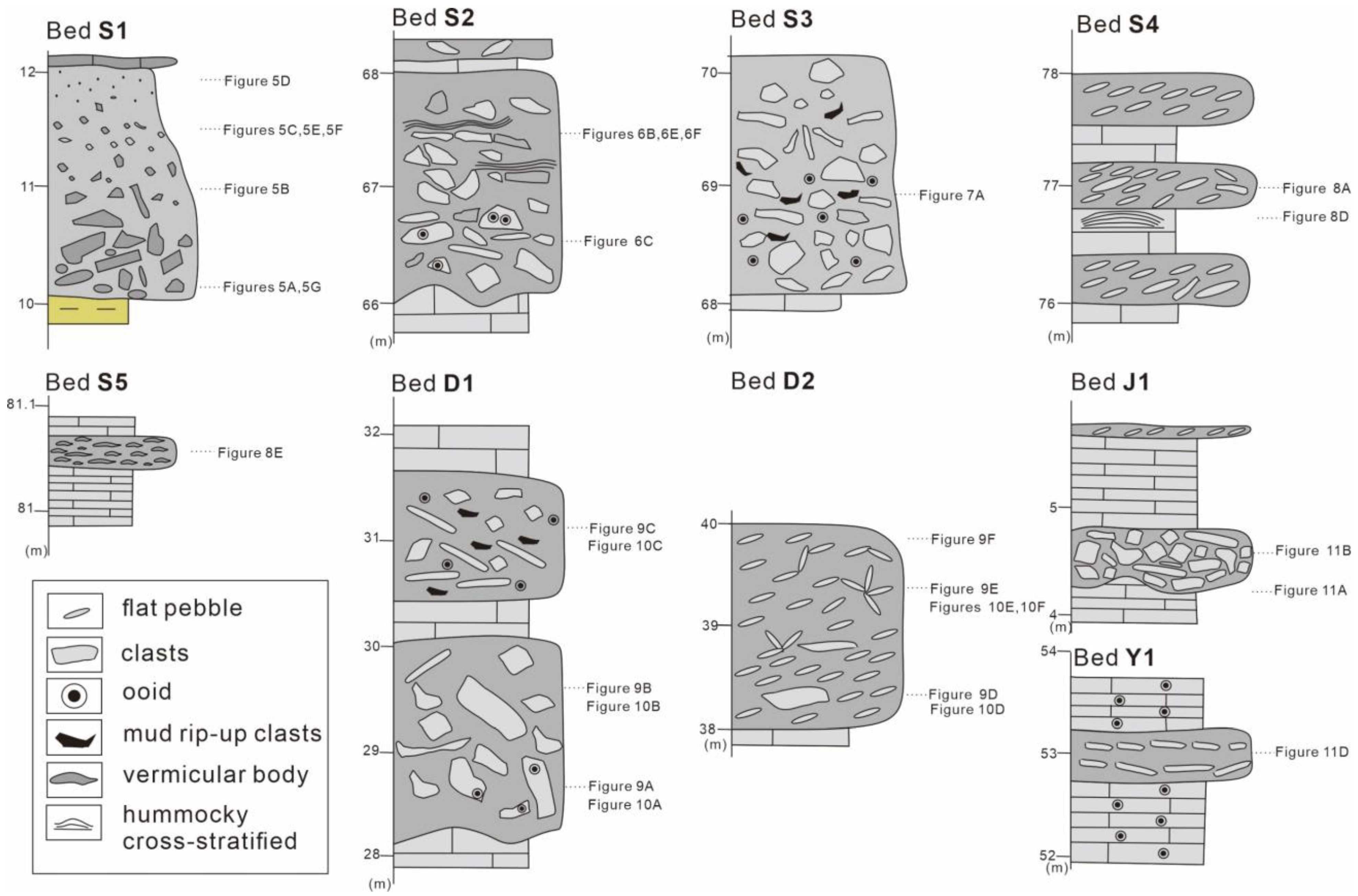

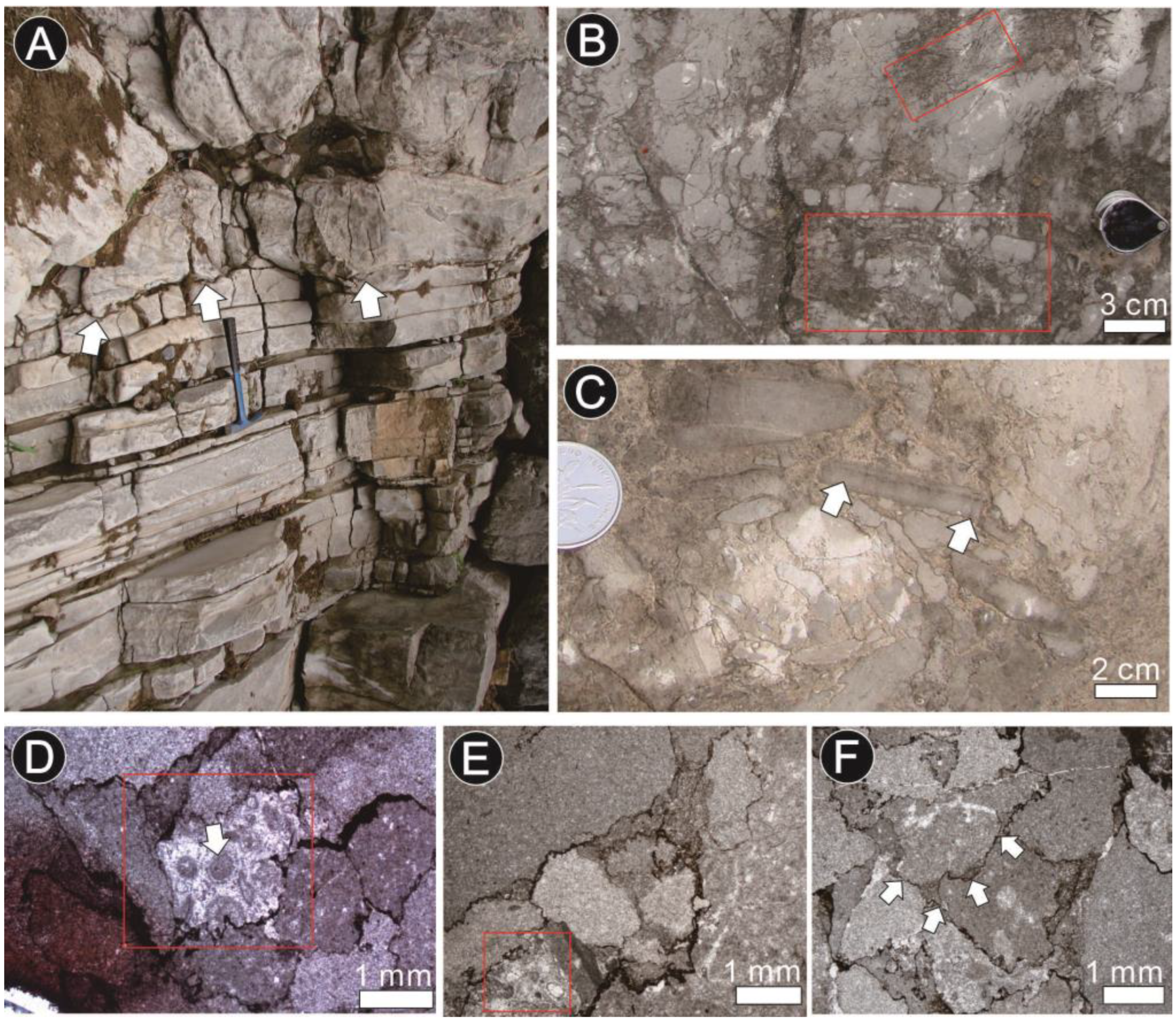
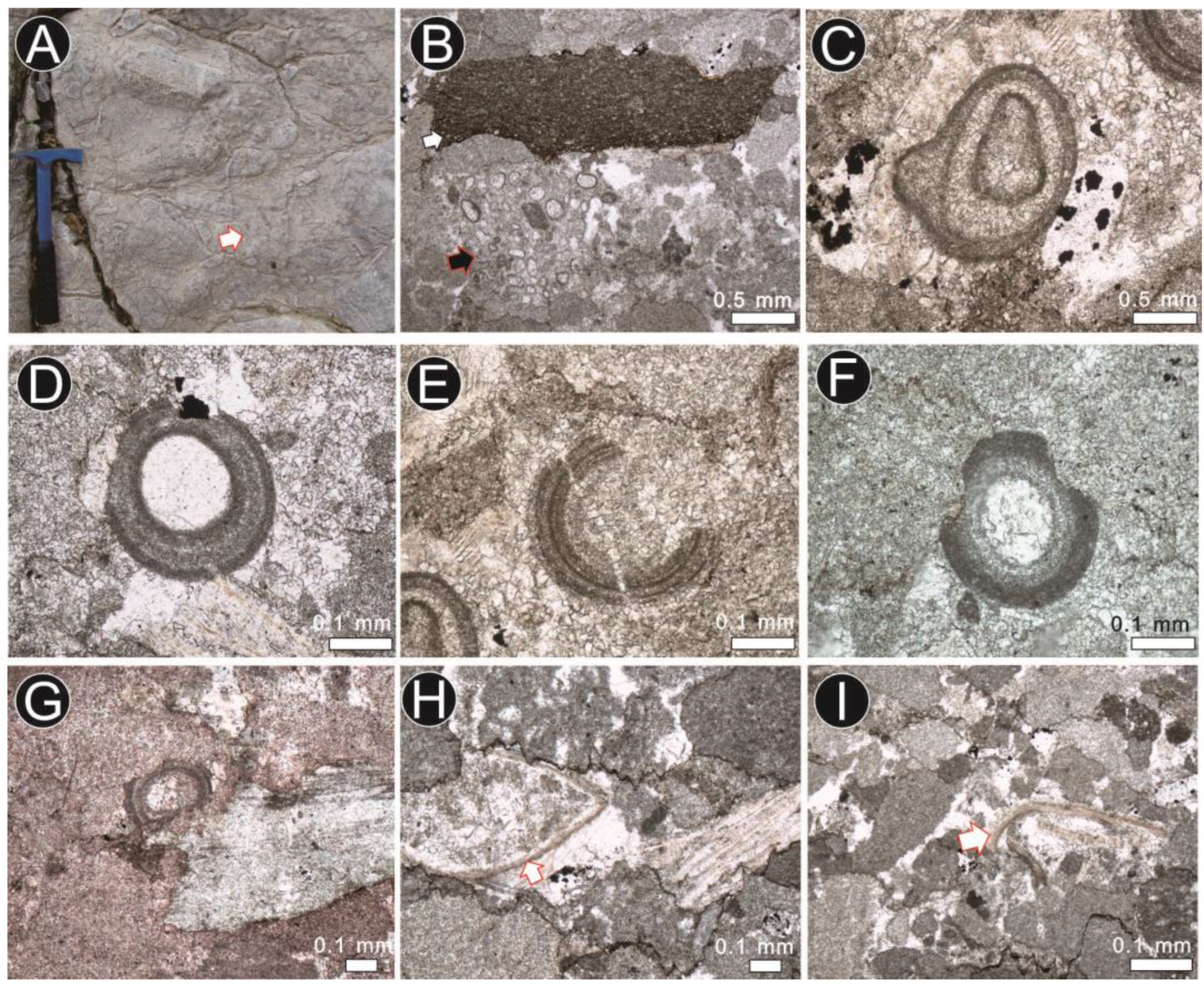
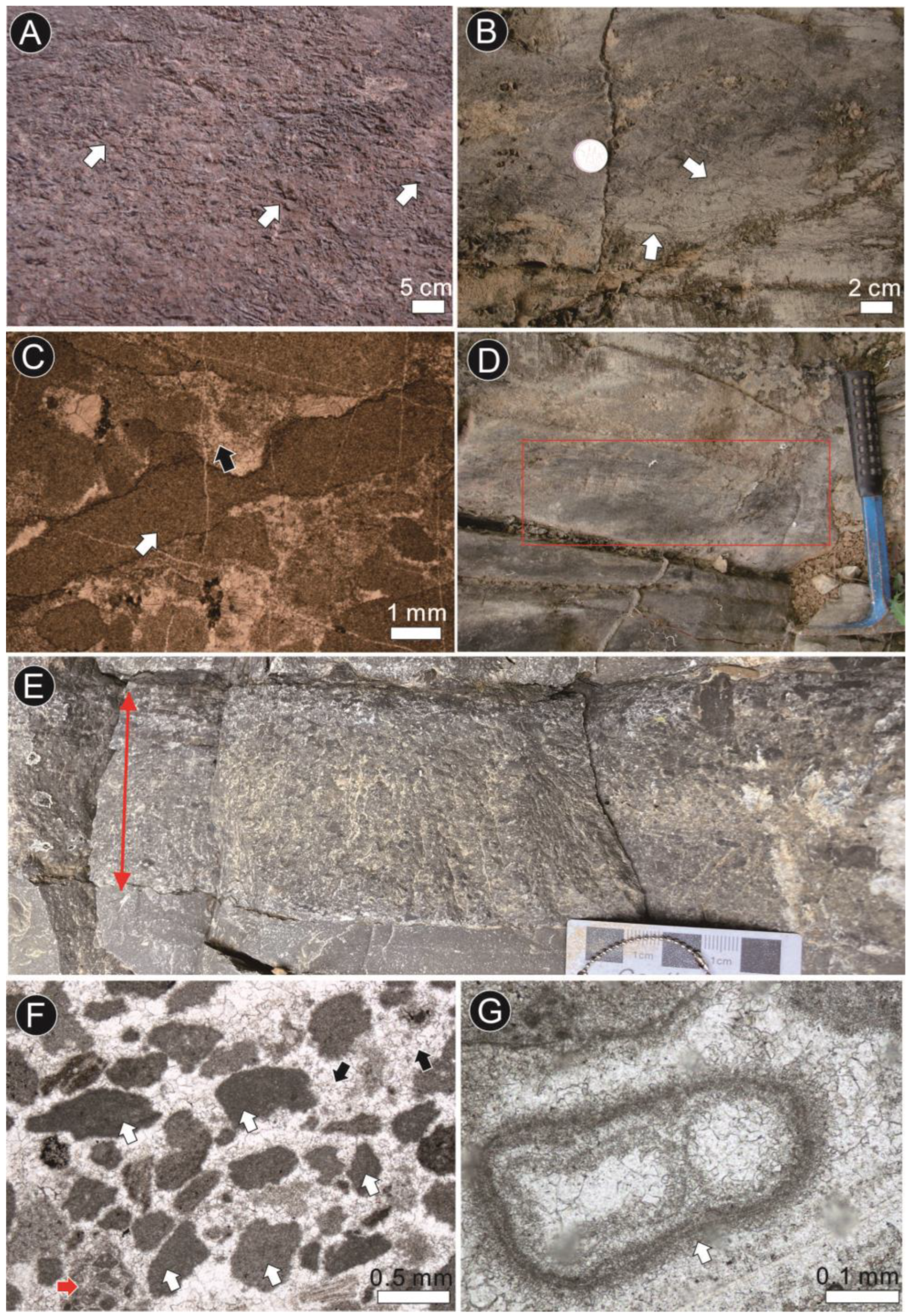
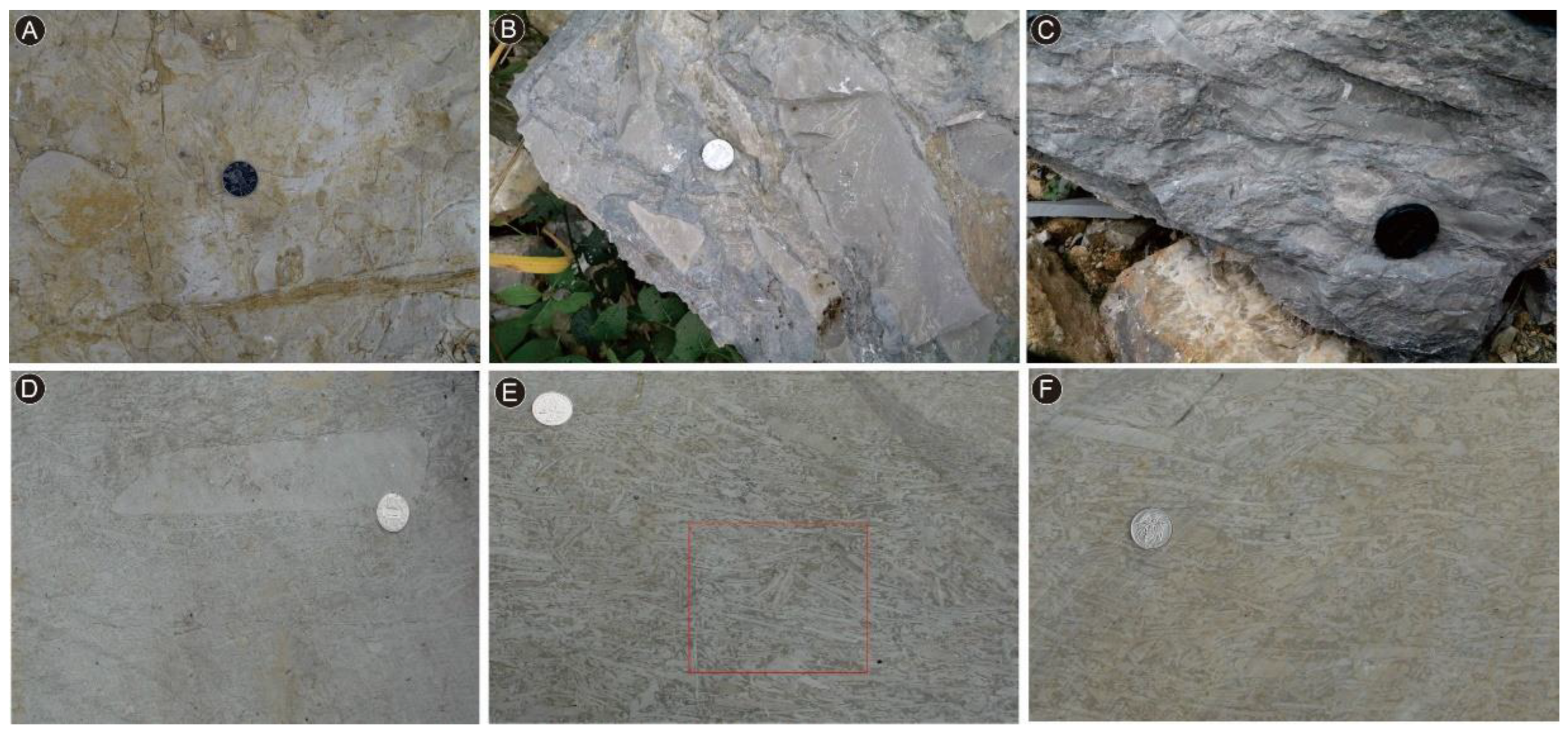
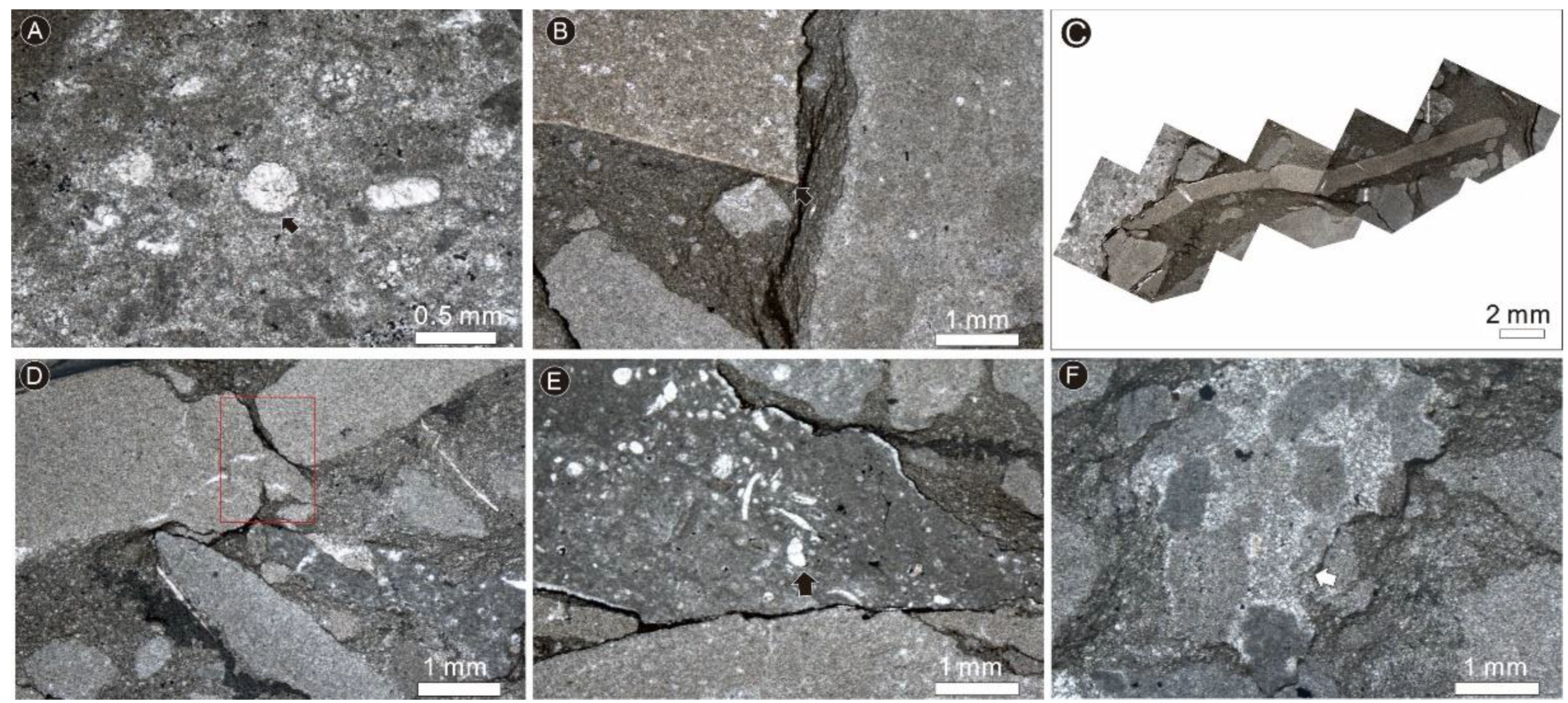
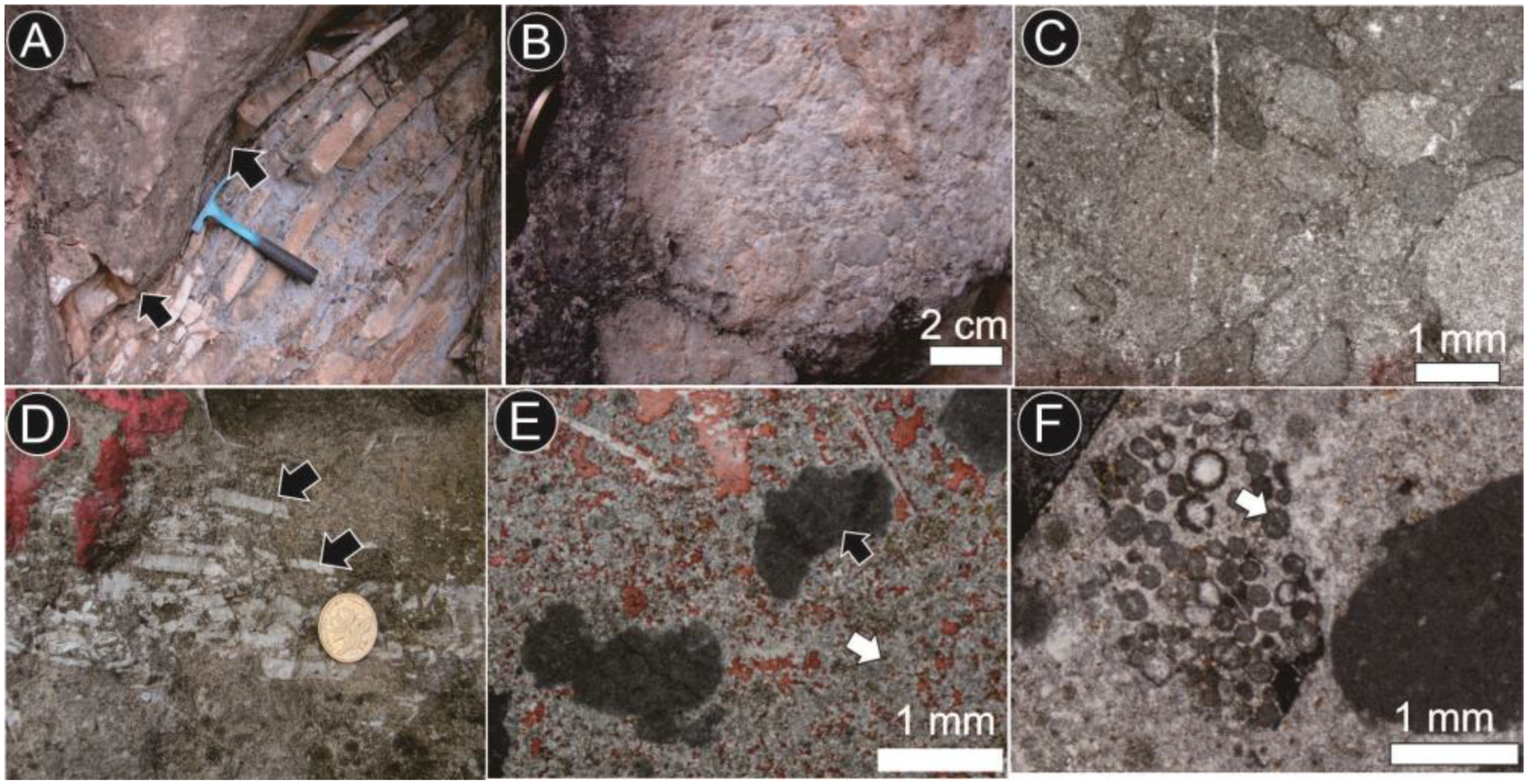
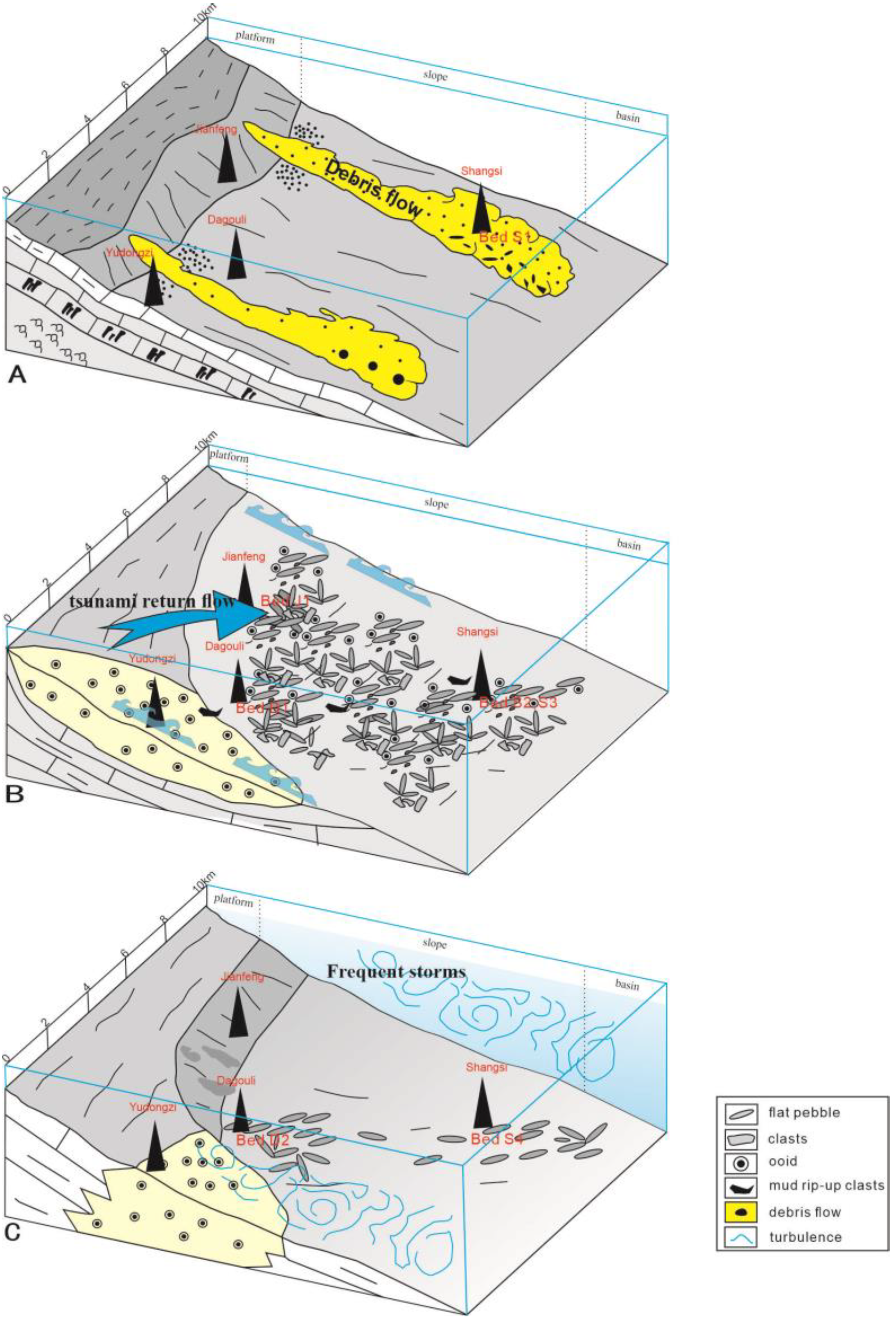
| Section Name | Coordinates | Sample Location | Total |
|---|---|---|---|
| Shangsi | 105°28′13″ E 32°18′30″ N | Ten samples were collected at Bed S1 with a sampling interval of 10 cm; twenty-five samples were collected at Beds S2 and S3 with a sampling interval of 10 cm; ten samples were collected at Bed S4 with a sampling interval of 5 cm; ten samples were collected at Bed S5 with a sampling interval of 10 cm. | 55 |
| Jianfeng | 105°21′41″ E 32°17′23″ N | Twenty samples were collected at Bed J1 with a sampling interval of 5 cm. | 20 |
| Dagouli | 105°16′49″ E 32°17′35″ N | Thirty samples were collected at Bed D1 with a sampling interval of 10 cm; fifty-five samples were collected at Bed D2 with a sampling interval of 10 cm. | 85 |
| Yudongzi | 105°06′08″ E 32°02′35″ N | Twenty samples were collected at Bed Y1 with a sampling interval of 5 cm. | 20 |
| The positions of beds S1-S5, J1, D1, D2, Y1 are shown in Figure 2. | 180 |
Disclaimer/Publisher’s Note: The statements, opinions and data contained in all publications are solely those of the individual author(s) and contributor(s) and not of MDPI and/or the editor(s). MDPI and/or the editor(s) disclaim responsibility for any injury to people or property resulting from any ideas, methods, instructions or products referred to in the content. |
© 2023 by the authors. Licensee MDPI, Basel, Switzerland. This article is an open access article distributed under the terms and conditions of the Creative Commons Attribution (CC BY) license (https://creativecommons.org/licenses/by/4.0/).
Share and Cite
Qiao, D.; Duan, X.; Shi, Z. Early Triassic (Griesbachian) Deposits of High-Energy Events at the Northwestern Upper Yangtze Region, China. Minerals 2023, 13, 1222. https://doi.org/10.3390/min13091222
Qiao D, Duan X, Shi Z. Early Triassic (Griesbachian) Deposits of High-Energy Events at the Northwestern Upper Yangtze Region, China. Minerals. 2023; 13(9):1222. https://doi.org/10.3390/min13091222
Chicago/Turabian StyleQiao, Dan, Xiong Duan, and Zhiqiang Shi. 2023. "Early Triassic (Griesbachian) Deposits of High-Energy Events at the Northwestern Upper Yangtze Region, China" Minerals 13, no. 9: 1222. https://doi.org/10.3390/min13091222





